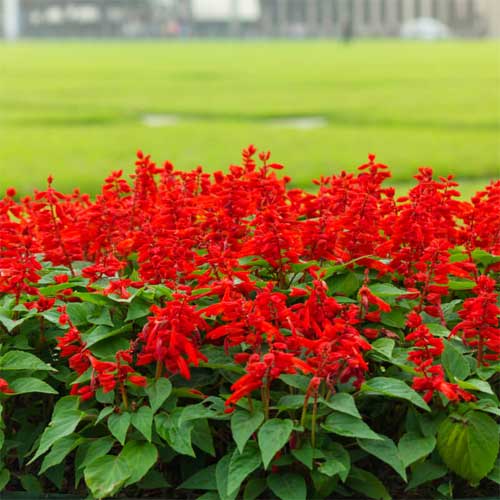Total Number of seeds: 50
Salvia Red Splendens Saint John's Fire Seeds produce fiery red blooms on long, elegant spikes. These winter season flowers are perfect for garden beds, borders, and pots, offering striking color and charm to any outdoor space.Salvia Red Splendens Saint John's Fire Seeds
Type of Seed: Salvia Red Splendens Saint John’s Fire
Germination Time: 7-10 days
Hours of Sunlight Needed: Full sunlight to partial shade
Where to Grow: Suitable for garden beds, borders, and pots
Growing Season: Winter season flower
Seed Sowing Depth: 1/8 inch
Ideal Climate: Cool to moderate temperatures
Bloom/Plant Height: 40 cm
Flower Type: Red, long spikes up to 25 cm
Organic Fertilizer Requirements: Feed every 2-3 weeks
Life Span: Annual
Ideal Growing Temperature: 15-25°C
Blooming/Harvesting Time: Blooms within 8-10 weeks after sowing
Maintenance Requirements: Low maintenance
Watering Frequency: Moderate; keep soil moist


Salvia St. John’s Fire thrives during India’s winter season. Sow seeds from October to February for vibrant red blooms.
Choose a pot with good drainage and a depth of at least 8-10 inches.
Use loose, well-draining soil mixed with organic compost.
Sow seeds on the soil surface and cover lightly.
Place the pot in a sunny or partially shaded spot.
Water regularly to keep the soil slightly moist but not soggy.
Preparation: Loosen soil and mix with organic compost.
Sowing: Sow seeds thinly and cover lightly with soil.
Watering: Mist gently to maintain soil moisture.
Germination: Expect seedlings to sprout in 7-10 days.
Transplanting: Thin seedlings as needed for proper spacing.
Sunlight: Full sunlight to partial shade ensures vibrant blooms.
Soil: Fertile, well-draining soil enhances growth.
Fertilization: Apply organic fertilizer every 2-3 weeks for continuous blooming.
Pruning: Remove faded flowers to encourage more blooms.
Pest Control: Inspect regularly for aphids or whiteflies and treat promptly.
Disease Prevention: Avoid waterlogging to reduce the risk of root rot.
1. Use Nutrient-Rich Fertilizers When Flowering Starts
When your flowers start to bloom, use nutrient-rich fertilizers like Organic Bone Meal Powder or Super Meal Organic Manure. These options help your plants produce bigger and brighter blooms.
2. Choose Organic Fertilizers
Opt for organic fertilizers such as Vermicompost Fertilizer or Cow Dung Manure Fertilizer to naturally boost plant health and improve soil quality.
3. Fertilize at Regular Intervals
Apply fertilizers every 20-25 days using products like Neem Cake to ensure your flowers get a steady supply of nutrients
This compact variety features bold red spikes that create a stunning visual display. Ideal for attracting pollinators like bees and butterflies.
Ideal for garden beds, pots, and borders.
Low-maintenance and beginner-friendly.
Attracts bees, butterflies, and hummingbirds.
Perfect for creating colorful landscapes and garden decor.
Avoid overwatering to prevent root rot.
Ensure proper spacing to maintain airflow and reduce fungal risks.
Protect young plants from frost in extreme winters.
Problem: Poor blooming
Solution: Provide adequate sunlight and use balanced fertilizer.
Problem: Yellowing leaves
Solution: Improve soil drainage and avoid overwatering.
Problem: Pest infestations
Solution: Use neem oil or insecticidal soap to manage pests.
Q: Can Salvia St. John’s Fire be grown in pots?
A: Yes, it thrives in pots with proper care and soil conditions.
Q: When does this variety bloom?
A: It blooms within 8-10 weeks after sowing during the winter season.
Q: How tall does this variety grow?
A: The plants grow up to 40 cm in height.
Q: Is this flower suitable for borders?
A: Yes, its bold red spikes make it an excellent choice for borders.
Local Names of Salvia: Commonly referred to as Sage Flower or Salvia.
Sign in now to receive a 5% instant discount on your first order when using code WELCOME. Begin your organic journey today!
By logging in, you're agreeing to our Terms of Service and Privacy Policy.
Ramesh
Salvia ke bright red flowers ne garden ko ekdum festive look diya.
Vikram
Kaafi thick spikes aaye with multiple buds per stem.
Kunal
Red color ka glow subah ke sunlight mein aur bhi zyada dikhta hai.
Dev
5 din ke andar hi germination start ho gaya tha.
Harsh
Salvia plant ka height bhi perfect tha decorative purpose ke liye.
Sameer
very good quality of seeds. germinate well and give a lot of flowers
Akash
Seeds bilkul fresh the, no damage at all.
Rina
Main isse phir se next season ke liye order karungi.
Neetu
Balcony pots mein bhi accha grow ho gaya without any issue.
Naresh
Garden border line decorate karne ke liye best plant hai.